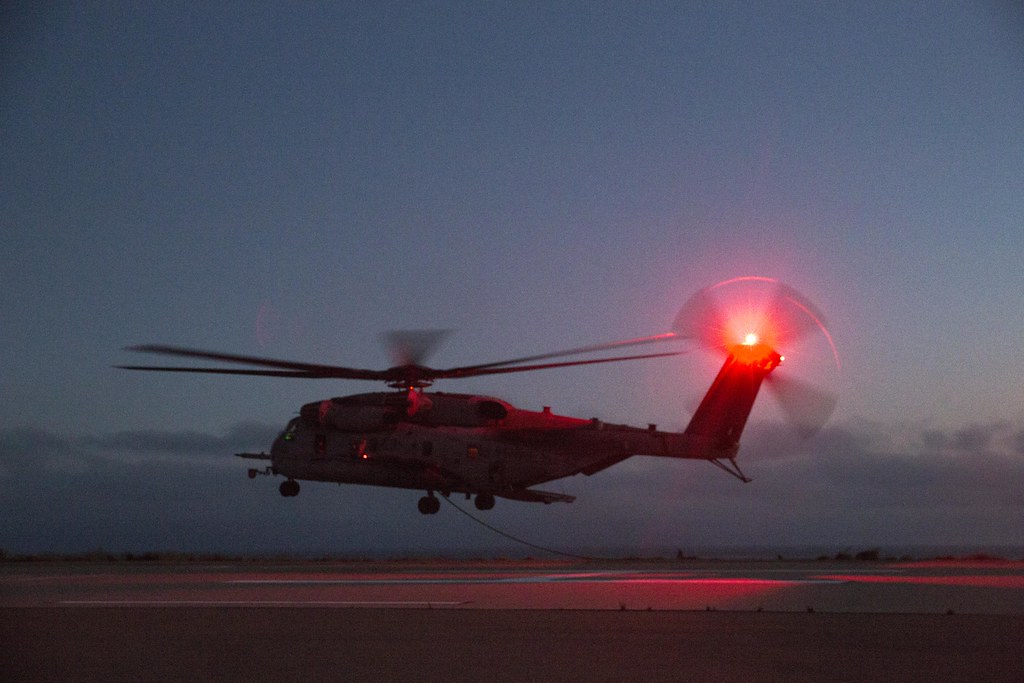
ќписание: Marine Corps Base Camp Pendleton, California - A Sikorsky CH-53E Super Stallion with Marine Heavy Helicopter Squadron (HMH) 466 prepares to receive Marines from Golf Company, Battalion Landing Team 2nd Battalion, 1st Marine Regiment on Marine Corps Base Camp Pendleton, California, July 2. The helicopterТs air crew and the infantry Marines conducted night fast-rope training, a useful skill for both units. MARINE CORPS AIR STATION MIRAMAR, Calif. -- Out of the darkness, the distinct growl of a CH-53E Super Stallion reaches across a dimly lit horizon. It stops, hovering at the right height before a rope drops from its Уhell hole,Ф a hatch in the helicopterТs floor. In seconds, a squad of Marines pours out, collects the tools of their trade and vanishes into the night. The MarinesТ ability to operate with precision in darkness is a substantial asset. Marine Heavy Helicopter Squadron (HMH) 466, the 'Wolfpack,' conducted evening fast-rope training with 76 infantry Marines from Golf Company, Battalion Landing Team 2nd Battalion, 1st Marine Regiment at Marine Corps Base Camp Pendleton, California, July 2. Nighttime fast-rope training enables Marines to practice inserting into an area under the cover of darkness without landing the aircraft. УThe purpose is for Marines, both infantry and air crew, to gain proficiency and experience,Ф said Capt. Joseph Tremaine, a CH-53E Super Stallion pilot and quality assurance officer with HMH-466. У[They need] to get on and off the helicopter in a safe manner.Ф The Wolfpack flew a single CH-53E Super Stallion and worked quickly, providing ample opportunity to rehearse the maneuver. 1st Lt. Ryan Hilgendorf, the executive officer of G Co., BLT 2/1, explained that fast-rope training is imperative for the Marines in the command. УWe must be able to insert into an area [using fast rope] via [helicopter],Ф said Hilgendorf. УItТs more tactical with a higher probability of success.Ф The infantry Marines arenТt the only ones who benefited from the training. The pilots and aircrew honed critical skills, safely operating their helicopters in a low hover above the ground in near-total darkness. УFlying at night definitely tactically aids us. ItТs another tactic that keeps the enemy from targeting us [and] firing [at] us,Ф said Tremaine. УObviously, doing things at night is tougher. [ThereТs] less visibility ... so you really need to have that muscle memory down in order to execute the proper procedures.Ф Fast-rope training can be a rare opportunity, but is very useful for the aircrew, said Tremaine. УItТs important that we hold a steady hover to ensure the safety of the guys getting out of the aircraft,Ф said Tremaine. УItТs good training for us to make sure we practice our techniques and go through our specific [communications].Ф
Tags:
ѕоиск и фотоизображени€ предоставлены компанией Flickr с помощью сервиса Flickr API согласно ѕравилам пользовани€ сайтом Flick.com и его сервисами. √рафические изображени€ €вл€ютс€ публичными, размещЄнными их авторами в свободный доступ (Public) и физически расположены на серверах Flickr. ¬се права на фотографии принадлежат их авторам согласно пользовательскому соглашению сервиса Flickr.com и охран€ютс€ законами, регулирующими авторские права.